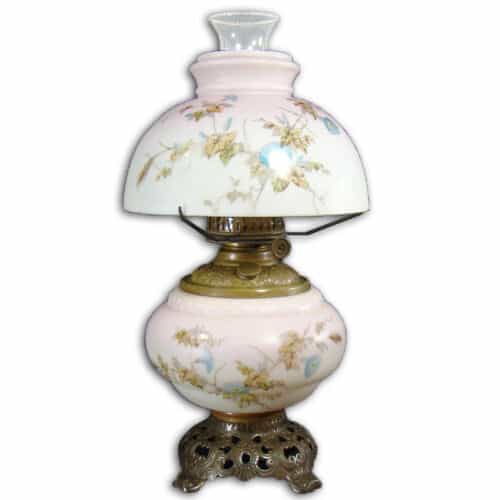Have you ever heard of kerosene banquet lamps? You might not have heard the term, yet you might have one that you have inherited hiding in the attic or the garage. And if you have, it could be worth a good deal of money.
But what exactly are kerosene banquet lamps? How do you identify an antique lamp and what are they worth? Read on to find out, as we have collected all that information about antique kerosene banquet lamps into this article.
Table of Contents
What is a Kerosene Banquet lamp?
Let’s begin by considering what kerosine lamps are first. Kerosene lamps were used to give light in the days before electric lighting. They were vessels that contained kerosine and had a wick for burning. Kerosene banquet lamps were popular in the late 19th century until electric light bulbs made them lamps obsolete.
A kerosene banquet lamp is not the same as an oil banquet lamp. Kerosene lamps were safer than oil lamps and were simpler to operate. They had a knob to adjust the brightness and a glass chimney to protect the flame from the elements. If you are interested in finding out more about the history of kerosene lamps, Antique Lamp Supply goes into further detail.
So what were banquet lamps? The Merriam-Webster dictionary defines a banquet lamp as “a tall elaborate kerosene table lamp”. The kerosene banquet lamps had decorative stems and globes which were decorated and painted. Most banquet kerosene lamps were taller than regular kerosene lamps, up to 40 inches with the chimney.
Makers of Kerosene Banquet lamps
There have been many companies that have made kerosene banquet lamps. However, some manufacturers were more significant and often lamps made by them are worth more. Let’s find out more about these makers of kerosene banquet lamps.
Bradley & Hubbard
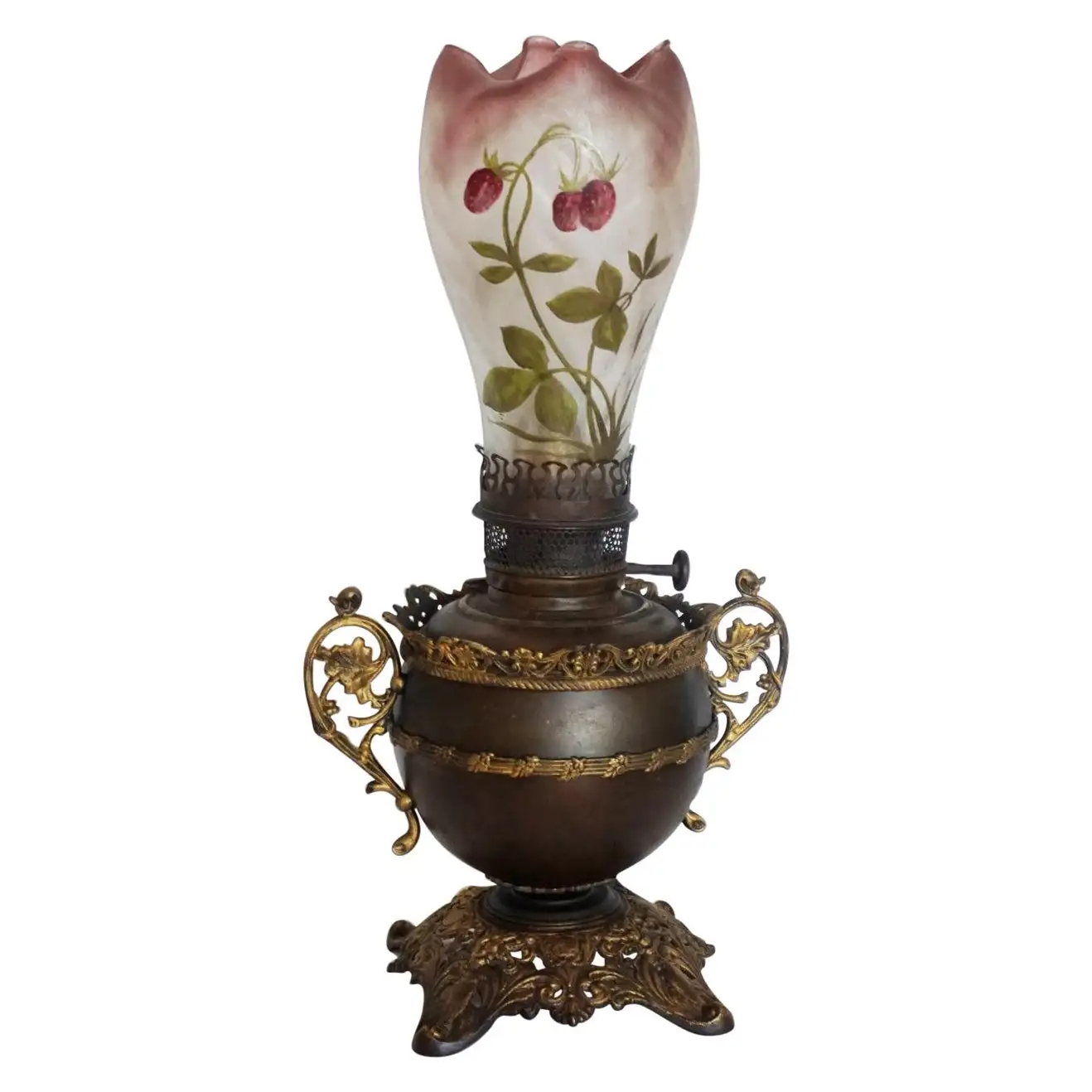
Bradley & Hubbard is one of the most recognized makers of kerosene lamps, including banquet lamps. The company was started by Walter Hubbard and his brother-in-law Nataniel Lyman Bradly in 1854 in Meriden, Connecticut.
They mainly made clocks, bells, and sewing machines before they found success with kerosene lamps with glass shades in the 1870s. The company was bought by the Charles Parker Company in 1940.
Miller
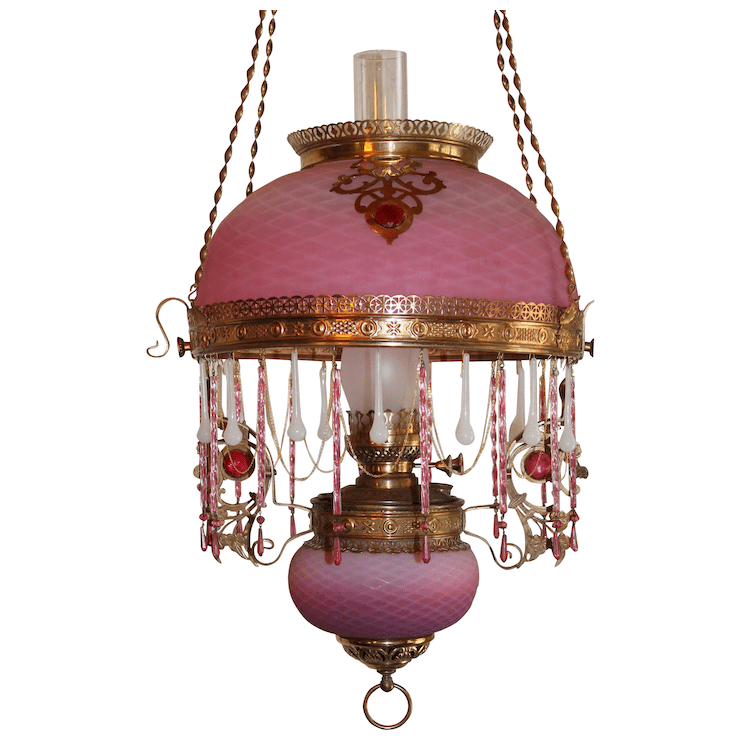
Just like Bradley & Hubbard, the Miller company started in Meriden, Connecticut, as well. When the company started in the 1840s, it sold camphene and burning fluid burners. By the 1860s, the company had become a manufacturer of kerosene lamps.
From 1890 until 1900, when the production of kerosene lights was at its peak, Miller made lamps for his own range and parts for wholesale. Sometimes lamps with Miller parts are mistakenly identified as Miller lamps. However, only those with his brand name on the fount are true Miller lamps.
Pairpoint
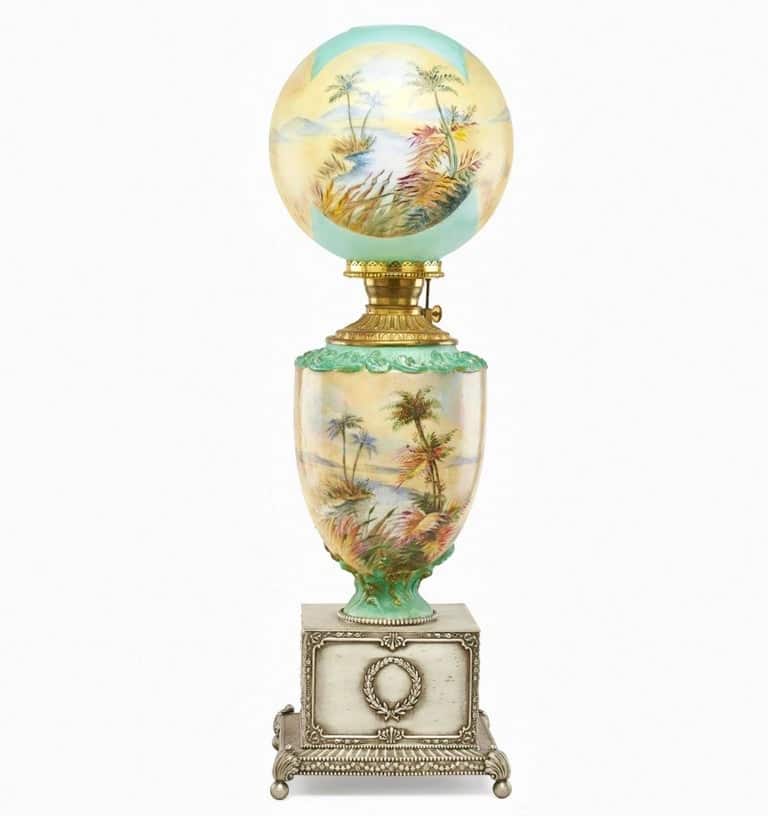
The Pairpoint Manufacturing Company started in 1880 in New Bedford, MA. Initially a maker of coffin fittings and metalwork, the company merged with a neighboring business Mt. Washington Glassworks. Following the merger in 1894, they began manufacturing lamps and lamp accessories.
Between 1895 and 1940, Pairpoint was best known for the glass shades, which came in three different styles: reverse painted shades, ribbed painted scenic shades, and landscape shades. If you think you might have a Pairpoint kerosene banquet lamp, this website offers valuations and authentications.
Fostoria
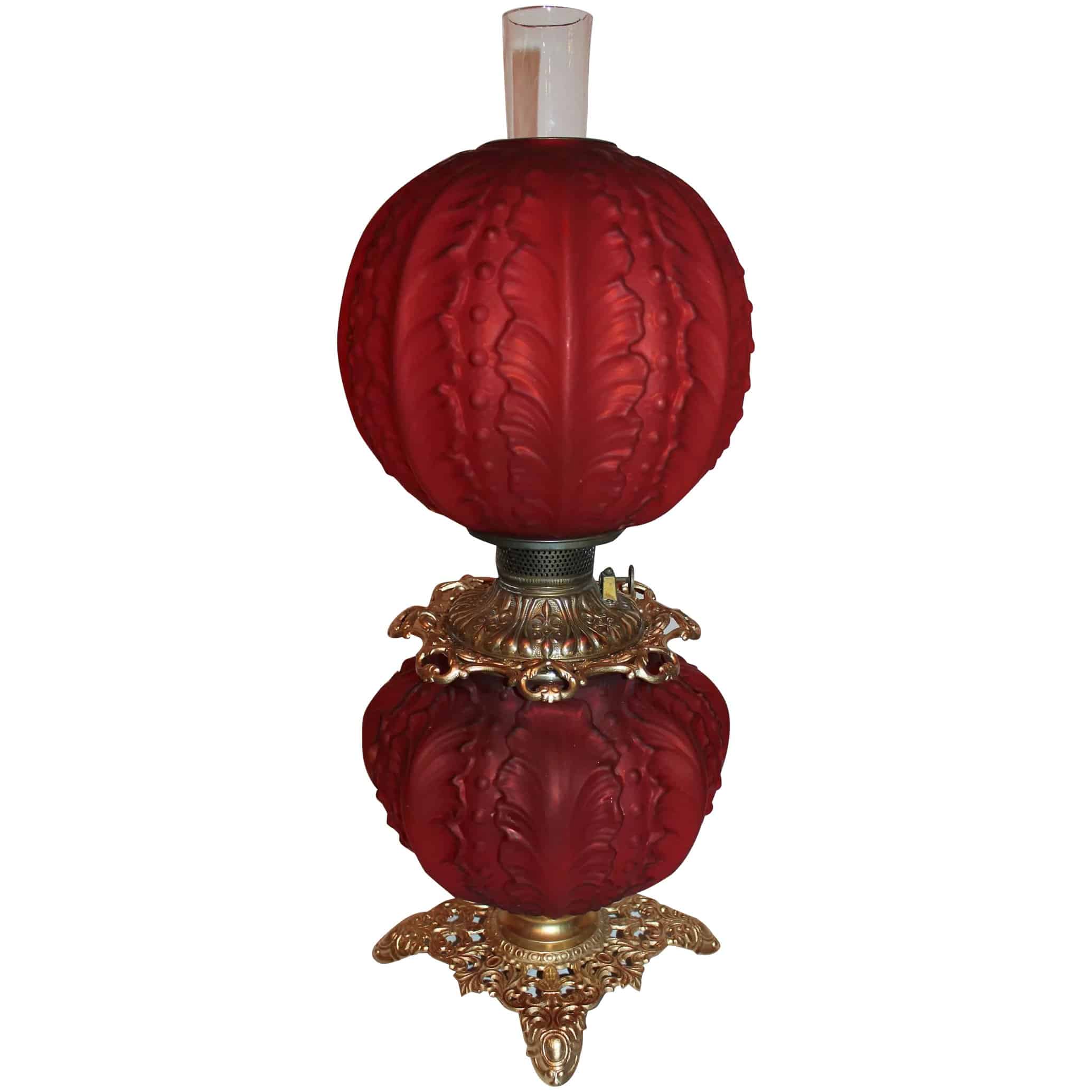
Henry A. Tremaine founded the Fostoria Incandescent Lamp Company in 1897 with his brother-in-law John B. Crouse. By 1899, the company had established its own glassmaking operations.
The company finished manufacturing lamps in 1914. However, the brand name continued for many years after that with its products being made by other factories.
Baccarat
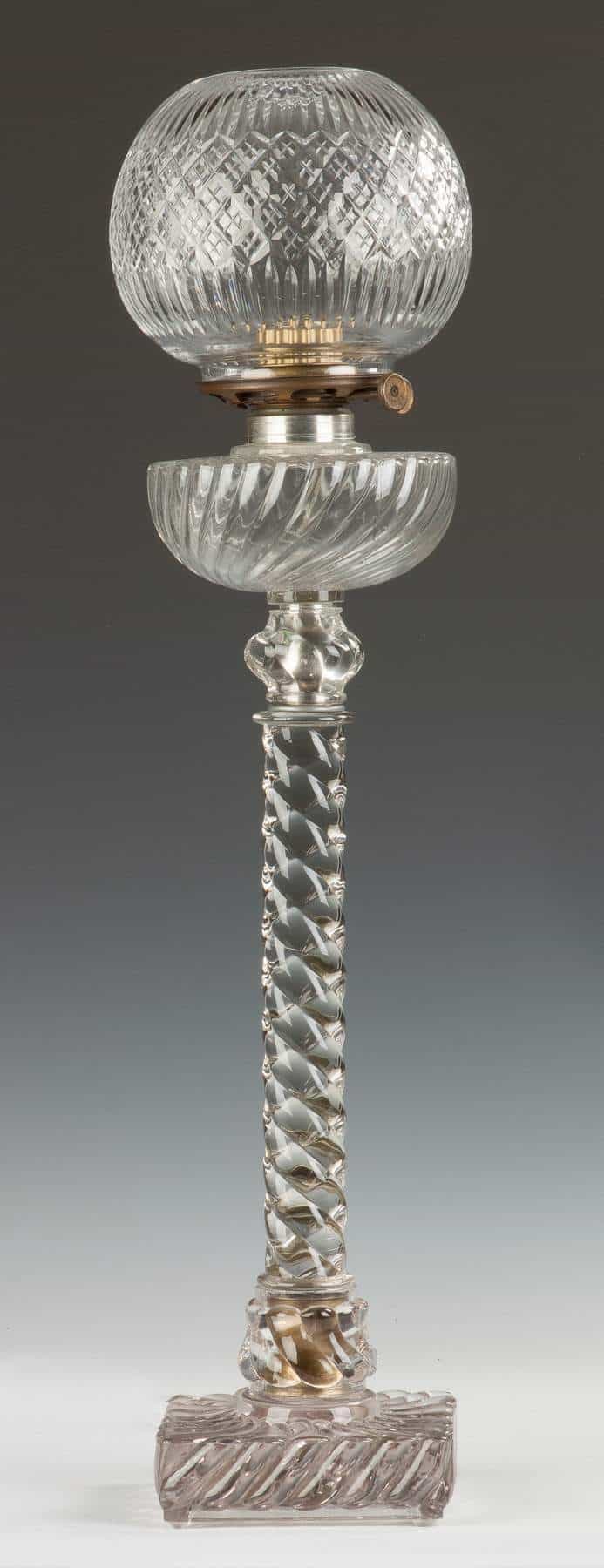
Baccarat is a French company that was founded in 1765 in Baccarat, France. When the company first started, it produced soda glass for windows, tableware, and industries. After it was acquired by a Belgian manufacturer in 1817, it began to specialize in producing glass and, more specifically, crystal.
The company has won awards for their glasswork and displaying their work at the 1925 Exposition Des Arts Decoratifs helped shape the Art déco style. The company still operates today and you can learn more about its history and products on its website.
How do you identify an antique Kerosene Banquet lamp?
Antique kerosene lamps come in various combinations of designs and materials. However, most of them have the same key characteristics that you can look out for. These include a decorative stem, a decorated circular glass shade or globe, a removable fount, and a vase.
Common materials used in antique kerosene banquet lamps included brass, bronze, and porcelain. The manufacturers of kerosene lamps also used various types of glass for the shade, which were milk, pattern, cased, cranberry, and satin glass.
Another way to identify antique kerosene lamps from other lamps is by the type of burners. There were three types of burners used in kerosene lamps: the coronet burner, the argand burner, and central draft burners. You can see what the different burners look like here.
Advice from an expert
Banquet lamps had their peak in the 19th century, but became popular again in the 20th century during the Victorian revival, leading manufacturers to produce them in millions. The lamps are still a popular collectible today and there are many reproductions on the market.
Here is what an expert says about how to spot an original from a reproduction.
- Expose the lamp to black light. Most new lamps are glued together, whereas vintage kerosene banquet lamps were fused.
- Check out the hardware. Old metal hardware is joined to the glass with plaster. In new lamps, it has been glued.
- The color and size can be another indication of the lamps’ age since many new lamps have colors not used in the original lamps.
To read these instructions in full and to view some examples, visit the Real or Repro website. This short video by The Ultimate Recycled also explains the differences between old and reproduced lamps.
Are antique Kerosene Banquet lamps worth anything?
When kerosene banquet lamps were first introduced, they quickly became a sign of the owner’s taste and wealth. They were used in the parlors at homes but also in reception halls of hotels and businesses as well as grand libraries.
When electricity became more common, some homeowners converted their kerosene lamps to work with electricity rather than discarding them. You can find these adapted versions on the market, too, so you need to check carefully when buying that the lamp is still in its original form.
What will affect the value of antique kerosene banquet lamps?
How much an antique lamp sells depends on various factors.
Age: When was it produced? Generally, the older the lamp, the higher the price. However, other factors need to be considered, too.
Condition: The lamp’s condition is key to determining its value. If the pattern of the shade is worn or there are cracks or chips on the lamp, the value will be diminished. Lamps that have all the original parts and are in excellent condition will be valued higher.
Rarity: How many copies of the lamp were made is another important factor. Or how many of them remain. The rarer the lamp, the more valuable it is, especially if it is still in good condition. Lamps with hand-painted designs or with elaborately decorated founts are more highly-priced.
History: Finally, does the lamp have interesting past owners? If the lamp has an interesting history that can be verified, it will be worth more to collectors.
How much are antique kerosene banquet lamps selling for?
Here are some examples of beautiful antique kerosene banquet lamps currently for sale. It will give you guidance on what is a fair price to pay and how to price your kerosene lamp when placing it on the market. The best selection of antique banquet lamps is currently on eBay. It is also worthwhile keeping an eye out for maps on the Ruby Lane website.
Dragon Awaji – $84,500.00, eBay
Etched Gilt Glass Lion Shade – $43,000, eBay
Victorian Lion Pairpoint Handel – $18,000, eBay
Boston Sandwich Cut EAPG Glass – $10,500, eBay
Sandwich Overlay Cut Glass – $5,999, eBay
EAPG Sandwich 19 C. Glass – $2,150 eBay
Bradley & Hubbard – €984, note this has converted to electricity, Etsy
If you are not keen on shopping online, you can try auctions, garage sales, and flea markets to find these special lamps. Use the guide we shared above to separate reproductions from originals.
Conclusion
Now that you know how to identify reproduced kerosene banquet lamps from original Victorian-era lamps, you can shop for them with more confidence. Remember when buying online to check the rating, customer experience, and history of the seller before making any purchases.
And if you are selling, the more details you can give the better as buyers prefer a seller who knows what they are talking about. If you have any questions about antique kerosene banquet lamps, add them in the comments section.
